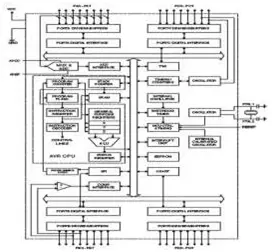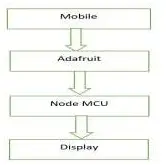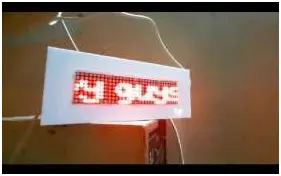Abstract
This Internet of Things (IoT) project utilizes speech recognition to display announcements on a light-emitting diode (LED) matrix notice board. By leveraging Google Assistant’s speech-to-text capabilities, notices can be verbally dictated rather than manually typed, saving time and reducing the risk of unauthorized modifications. The proposed system is built around an Arduino microcontroller and allows an authorized individual to provide voice commands that are converted to text by Google and then shown on the LED display. This secure, contactless solution streamlines the process of issuing notices while maintaining authentication through linkage to a Google account. With its voice input and electronic visualization capabilities, the system aims to modernize communication within an organization or public setting.
1. INTRODUCTION
This project allows users to display messages of their choice on a light-emitting diode (LED) matrix display. The display consists of 256 individually addressable LED lights arranged in an 8×32 grid. In addition to the display, a Node MCU controller facilitates wireless connectivity. Through a linked Google account on their Android device, users can verbally dictate messages which are converted to text via Google Assistant speech recognition. Power is supplied via a USB cable. The converted text output is shown on the display in an alphanumeric format. Depending on the size of the message relative to the display, the text will either scroll continuously or remain static. Potential applications include notice boards in offices, schools, government buildings and corporate headquarters where important announcements need to be conveyed. By utilizing voice input and digital display, this project aims to modernize messaging in an efficient, contactless manner that saves time compared to traditional paper postings.
2. TECHNOLOGIES USED
ARDUINO
As an open-source hardware platform, Arduino is commonly used for building various projects and prototypes. Arduino boards feature Atmel AVR microcontrollers that are 8-bit with variations in pin counts, memory sizes, and capabilities. These boards serve as prototypes that can be incorporated into circuits through physical connections. The microcontrollers come pre-programmed with a bootloader that facilitates simple uploading of programming code directly to their on-board flash memory chips. This makes Arduino boards readily programmable and customizable for a wide range of applications. The open design enables developers to easily interface sensors, actuators and other components for research, education and commercial purposes. Arduino’s widespread adoption stems from its accessibility, customizability and affordability as a platform for physical computing and interactive object projects.
BLUETOOTH
Bluetooth is a wireless technology that enables convenient data transfer between devices over short distances. It uses short-wavelength radio transmissions to form personal area networks (PANs) and connect devices like mobiles, laptops, headphones, printers and more. Bluetooth has simplified communication by removing wired tethers between technologies. Through its cable-free functionality, Bluetooth allows devices to interact within a small radius without the hassles of physical connections. With a low-range wireless signal, Bluetooth transforms how users share data seamlessly between their personal electronic devices over short transmission spans. This has streamlined connectivity and enriched the user experience of mobile and networked technologies.
ARDUINO ATMega
The ATmega microcontroller is a variant that features a Reduced Instruction Set Computing (RISC) architecture. The “AT” prefix refers to the chip’s manufacturer, Atmel, while “Mega” denotes that it is part of the Atmel Mega AVR line of microcontrollers containing flash memory. Built upon a RISC design principle, the ATmega aims to maximize performance and efficiency through simplified, optimized instruction sets. This allows for a smaller, less expensive chip compared to more complex instruction set counterparts. The ATmega microcontrollers have found widespread use in affordable embedded systems and IoT devices requiring 8-bit processing power due to their balance of capabilities and cost-effectiveness.

WIRELESS TRANSMISSION
Wireless transmission facilitates connection and exchange of data between devices without direct physical linking. Network connectivity allows information to be shared over the air instead of through manual cabling. This cable-free mode of communication simplifies data transfer by removing the hassle of wires or cords. Wireless signals are broadcast through the transmission medium, typically radio waves propagating through space. Antennas at both ends are used to send, receive and interpret these aerial signals, removing location and mobility constraints of wired networking. The convenience of wireless connectivity has transformed how people and devices interact remotely over local and global networks, offering freedom of movement without sacrificing real-time access to information.
3. COMPARISONS
Table-1
| Parameter | IEEE | IJSR-CSEIT | IRJET | IJEDR |
| Costing | High | Low | Low | High |
| Time span | Long | Short | Long | Short |
| Objective | Display text to Speech using Google Assistant. | Display message
using Android Bluetooth |
Display to digital LED & desired
information after necessary code conversion. |
Display public messages
to the masses on the LED matrix. |
| Features | Easy to operate at any distance location. | More efficient and Faster | Easy to use | Flexibility |
| Applications | Bus stationmaster and Notice boards | Railways and airport | School, banks and Offices. | Public places |
4. BLOCK DIAGRAM

5. ARCHITECHTURE- HARDWARE, SOFTWARE
Effective presentation of data is crucial for its meaningful use. This system employs a straightforward, user-friendly architecture that can be understood by all, facilitating smooth data flow. The smart display collects input from an administrator user. Arduino then processes this data and relays it to the display in a predefined format. Users can provide important schedules or upcoming events as input. Subsequently, the controller (Arduino) will notify the user accordingly and alert them to the scheduled event or deadline just fed into the system. A speech synthesizer module is also included, which accepts raw speech as input, processes it, and passes the audio commands to Arduino. These voice instructions can then trigger specific functions as needed. Through its simple and intuitive design, the system aims to efficiently relay pertinent information to users via multiple input and output modalities.


6. FLOWCHART

7. ADVANTAGES
Use of LED provides many advantages like
- low cost
- high brightness
- low power consumption
- ease of maintenance
- easily available
8. LIMITATIONS
- At a time only one user can login into the Google
- Every time Wi-Fi connection source changes, changes are required to be made in the
- Heavy
9. CONCLUSIONS
This project involves developing a notice display board using an LED matrix. Speech inputs will be provided to the system through integration with Google Assistant for speech recognition. Google’s speech-to-text capability will convert the voice commands to textual output, which will then be shown on the LED display.
The goal of this LED notice board project is to modernize and digitize the traditionally analog methods of paper and pin communications commonly found in educational settings like schools and colleges. By utilizing voice inputs interfaced with an electronic visual output, the system aims to revolutionize how notices and messages are conveyed – transitioning from static paper postings to a more efficient, interactive digital medium. This has the potential to streamline information dissemination while enriching the user experience through multimodal voice and display capabilities.
